#The winds that blew across Hyrule brought something other... :: [HEADCANONS]
Text
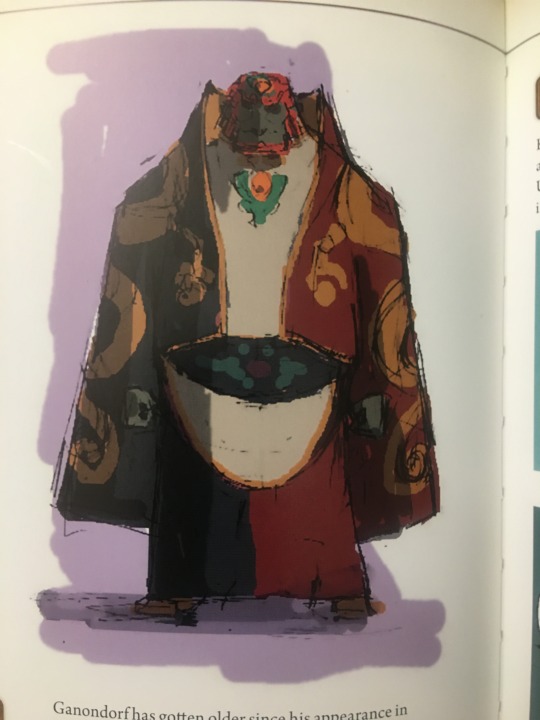
I was admiring Ganondorf’s concept art from the Wind Waker, but this one in particular stood out to me. I love the elegance of the two-toned robe and how it reminds me of the early Gerudo patterning! I can see why they didn’t opt to go with this as his final design, because it’s just too busy and thus visually is a little too distracting.
I really do like this robe though, and I now officially headcanon that it is something he does possess in his wardrobe! He HAS this and he DOES wear it!

The white undershirt and thin, long hair really do well for him here as well! Especially since they want to demonstrate how fatigued he is. He looks older, much more solemn. He probably does wear that comfy shirt under his clothes, and does grow his hair out too.
It’s just too bad he doesn’t have a his beard. I can't bring myself to have him shave his beard... It's a crime.
#out of time. :: [out of character]#The winds that blew across Hyrule brought something other... :: [HEADCANONS]#Forgotten Legend :: [THE WIND WAKER]
11 notes
·
View notes
Text
Young Gan being gifted that horse, likely expected to tame and bond with such a strong creature as a trial to help bolster his ascension to Kinghood.
But the poor kid isn't even tall enough to climb up onto him.
#The winds that blew across Hyrule brought something other... :: [HEADCANONS]#the first mountain the great king of evil conquered?#he horsey :-]
13 notes
·
View notes
Text
Anyways, Ganondorf is a feminist.
I don’t make the rules.
#Out of time. :: [OUT OF CHARACTER]#The winds that blew across Hyrule brought something other... :: [HEADCANONS]#I will elaborate later#i'm too lazy#i think the idea is pretty self-explanatory and obvious tho
15 notes
·
View notes
Note
Do you know how to dance?

"Kinghood is not simply a title bestowed upon a Gerudo man. Yes, it is my birthright, but before I could don the crown and ascend from Princehood to King of the Gerudo, it was my responsibility to embark upon a journey of comprehensive learning and arduous training: it was a regimen that spanned a multitude of subjects, all of which were vital to my succession. A wise Gerudo king must not only be learned, but he must have the experience to match his claims of knowledge."
"Among the many disciplines I was taught, dance held quite a prominent role. I was immersed in the traditional dances of my heritage and later on, I gained proficiency in a handful of Hylian waltzes in order to maintain formality and good faith among Hyrule's Royal Family and its many dignitaries."
"...You didn't ask, but among the many dances I have learned in my long life, there is one that resonates with me above all else and it is combat. It is a visceral, intimate change between adversaries, a ballet of blades, or fists, of wooden poles or steel staffs that demands both grace and precision. This particular dance is a true test of one's mettle and I find it is an art form that sharpens the senses to a razor's edge. Just like your typical dance, in combat, there is an unspoken dialogue that unfolds, it is an interplay of anticipation: each step taken is a measure of the your partner's movement. To engage in combat is to engage in a dance that lays bear the essence of one's character. A pursuit that demands not only mastery of the techniques themselves, but also an acute understanding of the opponent or partner. It is a dance that transcends mere physicality, delving into the realm of instinct for every performance."
"I hold a deep appreciation for the elegance and cultural significance of a myriad of dances, I have forged many cherished memories through dancing, particularly within the embrace of my own people. Through the language of traditional dance, I have cultivated many deep bonds and profound connections with a diverse array of cultures and the people they belong to. However, combat is a type of dance that speaks to the very core of who I am... It resonates with essense of my very being. Powerful and unrelenting."
#kneel. :: [inquiries]#The winds that blew across Hyrule brought something other... :: [HEADCANONS]#query-bot#thank you!!!! i love asks like this#take a shot every time you read the word “dance”
7 notes
·
View notes
Text
Let’s talk about Hyrule’s bestiary, shall we?
Tears of the Kingdom, and by association, Breath of the Wild makes this implication that all of Hyrule’s monsters are not a side effect but instead, a deliberate action of Ganondorf and his evil intentions, his malice and gloom. In fact, we quite literally see this in the Tears of the Kingdom trailer, and we see this in an in-game cutscene wherein he commands his monsters to rise up. Which, this isn’t the first time that a Zelda game ever suggests the presence of evil commands the existence of monsters, but I argue that this is a story beat that falls flat and in fact, I think there should be something more to these monsters’ existence; after all, this is a game series that reflects Miyamoto’s youth, mirroring his adventures in the Kyoto countryside, his discovery of that cave and his days-long hesitation to explore the inside of it.
The creator and executive producer of many of our beloved Nintendo franchises, Zelda is one of the purest representations of Shigeru Miyamoto, but more importantly, it represents his faith and his relationship with Shintoism. Shintō - the way (tō) of the gods (shin), is a broad, native-based faith that draws focus around remaining in touch with and respecting the kami, that is, gods, the nature spirits, or perhaps the spiritual energy, that are believed to inhabit all things: nature, animals, landscapes...
They are, essentially, the soul of everything.
Miyamoto actually lives close to the Fushima-Inari shrine, a beautiful place of worship at the base of a mountain (also called Inari) dedicated to one of the most familiar kami, Inari, (short for Ine Nari, or Ine ni Naru -- the reaping of rice) who is the god and protector of rice cultivation. Miyamoto has a very personal connection to Inari, believing this nature spirit to be his guardian angel. This shrine is considered to be the head shrine, the big boy among the other thirty-thousand other shrines dedicated to Inari across Japan. The shrine has been around since at least 711AD and is where billions of people have come to pray for a bountiful harvest, prosperity in personal endeavors, the safety and thriving of their family and loved ones, and protection of their home. Worshippers will trek through the approximately eight hundred Senbon Torii, these beautiful Torii gates that are erected in honor and deep thanks by those who have prayed at the shrine and have had their desire or wish come true.
I mention all of this in a post about Hyrule’s monsters because it’s this real-world inspiration that permeates Miyamoto’s video games, informing his game design philosophy. Something particularly iconic about Star Fox 64′s levels, for example, are the many arches you can fly your Arwing underneath and receive health rings or power-ups as a secret bonus reward. This is a direct reference to the Torii gates at the Inari shrine.
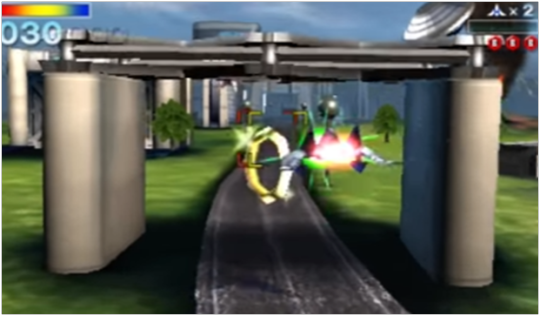

Purity is a very important component when it comes to Shinto rituals, such as kagura, a traditional dance that is meant to establish and maintain the perfect balance between nature, humans, and deities. Impurity, or more specifically, pollution is driven away by these rituals, as Shintoism suggests that it is considered a contamination and obstruction to the flow of life and thus the blessings from the kami.
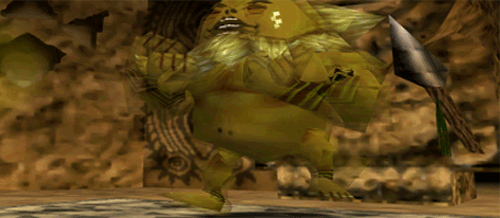
Tôru Ôsawa introduces this concept very, very effectively in Ocarina of Time. Young Link’s adventures across an untainted and pure version of Hyrule introduce us to two nature spirits, two kami, who are integral to the flourishing of their elemental domains. The Great Deku Tree and Lord Jabu-Jabu, both are honored as patron deities amongst their respective tribes. The Great Deku Tree embodies the eternal life, endless youth, and boundless spirit of the mysterious forest and Lord Jabu-Jabu is thought to protect the health and clarity of the water that runs down Zora’s river and crawls through the country, providing Hyrule with fresh drinking water -- the source of life itself.

The early part of Link’s adventure introduces us to these kami. When we begin the game we are introduced to the Great Deku Tree, who has fallen ill after being cursed by Ganondorf, and we are required to travel inside of this great nature spirit and purify him, destroy the monsters, rid our tree-daddy of the impurities inside of him, and cleanse this deity’s soul. When we are almost at the curtain-close of Young Link’s act, we travel inside another kami who is rife with pollution, and as Link, we must heal Lord Jabu-Jabu, who has also become “green around the gills” following a terrible encounter with Ganondorf.
While it’s not subjected to the same anthropomorphization of the other two kami, we know that Death Mountain is alive in its own right. Kaepora Gaebora once whispers to us that the state of the mountain, its mood and its health, can be determined with one glance up at the cloud that crowns Death Mountain’s summit. When Link is a child, he must explore the inside of Death Mountain, purifying one of its many caverns by eliminating the monsters that are infecting it like a virus. Large, dangerous boulders roll down the mountain face and threaten the safety of the sleepy Kakariko Village nestled at the foot of the mountain. These are all symptoms of the natural balance being skewed, of course, brought upon by Ganondorf’s wicked demands not being met.
The beginning of the game doesn’t just introduce us to the controls, pivotal characters and how the world of Hyrule works, but it also establishes this Shinto concept that there is supposed to be a perfect balance between nature, humans, and deities. In fact, this is symbolized in the Spiritual Stones that we collect as we unite and purify forest, water, and fire. While we’re on our journey of healing, we as the player are painted a perfect picture of what a healthy Hyrule looks like – what it should look like.
We know what happens next.
Shintoism doesn’t really promote any commandments for followers to live by in the same ways that a western, Christian-based faith might expect, instead only suggesting that the idea of living a simple and harmonious life with nature and people and is quite simple when adhering to the four affirmations of the Shinto spirit:
Love of nature; nature is sacred, to be close to nature is to be close with the kami
Family and tradition; the family is the primary mechanism by which traditions are preserved
Physical cleanliness; followers of Shinto take baths, wash their hands, and rinse out their mouths often.
Matsuri; to participate in festivals in which worship and honor are given to the kami.
While they aren’t particularly “good” or “evil”, kami are imperfect creatures and there are ways to upset them. Negative actions such as living outside of these four affirmations of the Shinto spirit and thus not living a simple and harmonious life with nature and people, or committing negative actions or evil deeds referred to as “kegare”, (literally meaning “dirtiness”), are an equivalent to committing a sin in the eyes of the kami. While most kami are usually fun-loving, benevolent and quite forgiving, there are kami who make mistakes or are quick to rash actions, and some may actively try to hurt people should they feel disrespected or taken for granted.
For instance, if a life is taken without gratitude for this ultimate sacrifice, the soul might experience “urami”—that is, it will hold a grudge. During the spirit’s ongoing rage and pain, it transforms into an aragami: a powerful and evil kami that seeks revenge.


By the time Link wakes up seven years later, Hyrule no longer resembles that perfect picture of harmony with nature, the deities, and humans. There’s a terrible gloom settled into most of the major locations of Hyrule that gives off this desolate, dying feeling to the rest of the country. Everywhere you look, dark clouds hang over the once vibrant skies of Hyrule; the forest is infested with wicked monsters that trap the Kokiri children and their fairies in their homes. Death Mountain is angrier than ever with the ring of clouds blazing with fire as a ferocious dragon now inhabits the volcano. The lake has dried up and Zora’s domain is completely frozen. All the while, a violent and vengeful shadow looms over Kakariko Village.

What can be misleading about this part is Rauru stating outright, that Ganondorf’s evil powers radiated from the temples of Hyrule, which kind of suggests what’s happening to the very nature of Hyrule is coming directly from Ganondorf himself as if he’s waving his hand and infecting these temples directly. However, I don’t believe this is the case. This is because of what I’ve established earlier, that due to the mistreatment of Hyrule itself; the balance between nature, humans, and deities has been skewed, the very land as a whole began to sour.
So yes, Ganondorf’s evil power did radiate from the temples, because these were places of worship, sacred temples that belonged to each of the races of Hyrule. Shrines to give thanks to the lands that take care of them, to show appreciation of one another, and to look up to the gods with gratitude. He stole something holy, and thoroughly abused it, disrespecting the Goddesses, abusing the nature of this beautiful country, and caused a horrible rift between the tribes who inhabit Hyrule, and as a result Hyrule rotted. Where gentle nature spirits once roamed, now only horrible monsters remain.
I don’t really believe that many of the monsters that infest the temples and attack Link among his journey are Ganondorf’s servants per se. Certainly, the Iron Knuckles are perhaps one of the only examples of proof of loyalty to Ganondorf’s cause, and even then, with proof of the (probably brainwashed) Gerudo warriors nestled inside of them, I’m not even sure you can call them monsters, anyways.
Why do I think this, then? Well, for starters…
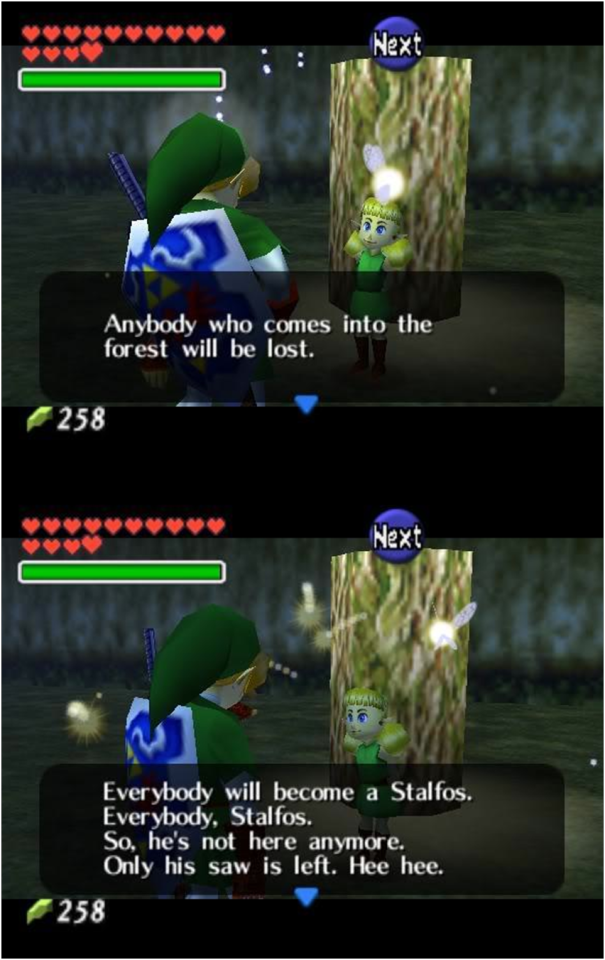
Are we to take Fado’s words to mean that as soon as Grog transformed into a Stalfos, he marched out of the forest and joined up with Ganondorf’s ranks? That’s a cartoonish thought, and while it is possible, it really contradicts with what Fado says specifically: that anybody that comes to the forest will be lost.
Lost is the keyword, there. You see, in a 1999 interview with 64Dream Magazine, Yoshiaki Koizumi, confirms that upon transforming into a Stalfos, Grog instead wandered off to the Forest Temple to live there. He also confirms that this is what happened to the child who stalks around the graveyard in Kakariko, the one who wishes to look scary, just like Dampé. According to Koizumi, five years after Ganondorf obtained the Triforce, the little boy left Kakariko in search of his missing father. Upon entering the Lost Woods, he soon transformed into a Skull Kid, and now fears all adults he encounters.

Even before Ganondorf’s reign of terror, the people of Hyrule were already disrespecting the natural world and its spirits. Taking into considerations the Odd Mushroom that Fado demands back from you upon discovering Grog’s absence because she says it belongs to the forest, or even the Eyeball Frog, who Koizumi confirms in 64Dream Magazine, are often used by those who don’t feel particularly sorry for their sacrifices. Perhaps this is why Stalchildren roam the fields at night, why Peahats often attack any adventurer who wanders too close to their nests, why Skulltulas remain nestled in dark, damp places because even before Ganondorf stole the Triforce, Hyrule was already growing sick from its inhabitants’ greed.
It definitely explains the existence of the Spiders of the Curse…
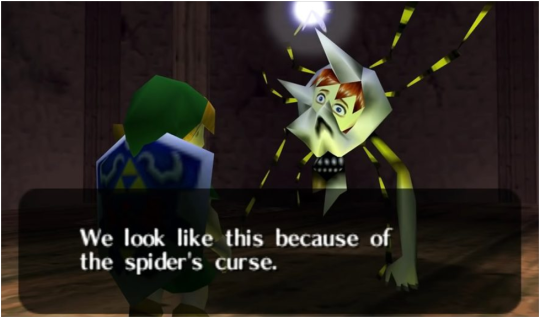
That’s why I feel the idea that Ganondorf purposefully raises the monsters out of thin air to act as his “servants” really takes away some larger nuance and deeper meaning from the Legend of Zelda series, but, hey, that’s just an old boomer’s take.
https://jref.com/articles/shint%C5%8D-the-way-of-the-gods.27/
https://www.bbc.co.uk/religion/religions/shinto/beliefs/kami_1.shtml
https://www.bbc.co.uk/religion/religions/shinto/texts/stories_1.shtml#h2
https://www.zeldadungeon.net/the-divinity-of-jabu-jabu-zeldas-kami/
https://femhype.wordpress.com/2016/05/10/japanese-environmentalism-shinto-the-legend-of-zelda/
https://killscreen.com/previously/articles/unmistakable-influence-shintoism-videogame-history/
https://www.zeldadungeon.net/wiki/T%C3%B4ru_%C3%94sawa
https://zeldauniverse.net/2011/09/14/immortal-childhood/
http://inari.jp/en/
https://en.wikipedia.org/wiki/Inari_%C5%8Ckami
https://en.wikipedia.org/wiki/Shinto
https://en.wikipedia.org/wiki/Fushimi_Inari-taisha
https://crafttabby.com/explore/nintendo-inari
https://www.youtube.com/watch?v=uYPKHbOD_xg
https://www.youtube.com/watch?v=GyUcwsjyd8Q
https://www.neoseeker.com/the-legend-of-zelda-ocarina-of-time/faqs/162138-zelda-64-script.html
https://www.armageddongames.net/archive/index.php/t-61081.html
http://forums.legendsalliance.com/topic/17108-list-of-japanese-translations/
https://www.thehyrulejournals.com/what-we-do
https://www.learnreligions.com/shinto-worship-traditions-practices-4570821
http://plaza.ufl.edu/sroy12/cgs3066/project2/beliefs.html
https://www.patheos.com/library/shinto/beliefs
https://archive.org/details/64dream-April-1999-ozidual/64Dream%201999%2004%20%28J%20OCR%29/page/n89/mode/2up
https://www.reddit.com/r/truezelda/comments/y13iic/some_minor_lore_details_from_the_developers_of_oot/
#The winds that blew across Hyrule brought something other... :: [HEADCANONS]#Land of Myth :: [OCARINA OF TIME]#Tear Stains :: [TEARS OF THE KINGDOM]#Ocarina of Time analysis#Legend of Zelda analysis#totk spoilers#i guess?
12 notes
·
View notes
Text
I've been meaning to tackle this absolute beast all fucking DAY LONG. Ganondorf's solid black Gerudo stallion.
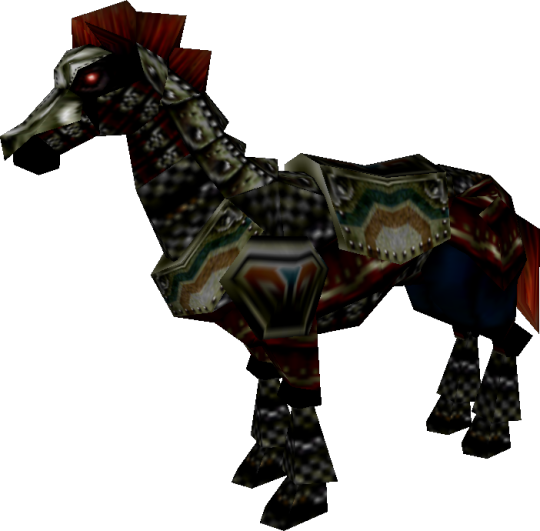
For what it's worth, I've touched on this monster in the past, at least with regard to BotW (and I suppose TotK's) changes. Specifically, naming the probable breed of horse and matching it to Ganondorf's usual sensibilities. The Percheron is quite literally a pedigree of power. It is a strong, working breed that is described as being incredibly loyal as both a companion and noble steed... And, of course, the largest known modern horse.
Anyways, rewinding back to Ocarina of Time, I wholly believed that this horse died sometime within the seven years that Link slept. I build this argument around two observable facts in the game: we never see Ganondorf riding it after Link falls asleep, and the fact that Ingo, the new owner and manager of Lon Lon Ranch is preparing Epona to present to the Great King Ganondorf. Why would he need a new horse?
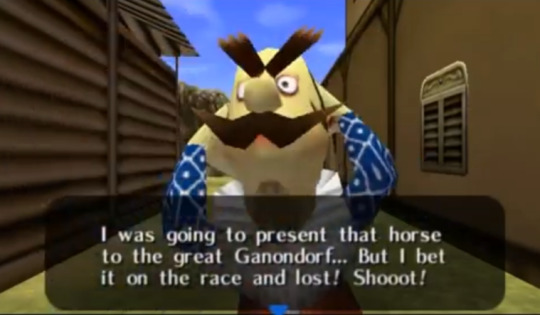
Sure, it could be said that this last argument is just a matter of Ingo showing his appreciation for Ganondorf giving the ranch to him, but... Let's think about something. After Link wakes back up, when is the next time we see Ganondorf's horse? Not at Ganondorf's side, but instead serving Ganondorf's phantom doppelgänger deep within the Forest Temple -- a stronghold of the forest that seems to attract the dead. You see, in a 1999 interview with 64Dream magazine, it's confirmed that not only those lost within the Lost Woods turn to Stalfos and look to the Forest Temple for solace, but also that the Forest Temple is indeed haunted, inhabited by the lost souls of those who wish to protect the temple from intruders. Despite the place being overgrown and flourished with plantlife, that stronghold is a place of death. This is a place where the dead go to be reclaimed by nature.
And thus, perhaps inevitably, where the spirit of Ganondorf's horse ended up as well.
(Another argument that helps me is the fact that Percherons have a lifespan of between 25 and 30 years, which does line up with the age range I can personally see Ocarina of Time Ganondorf settled in, his mid 30s and 40s. Didn't know where else to place this argument so cough coff--)
Anyways, lemme tilt the conversation a little bit away from our definitely-dead-now-totally-pure-glue horsey friend and look at Phantom Ganon from Ocarina of Time. I'm not gonna do the cliché thing and start telling you the dictionary's definition of phantom, because we all know what they are: fuckin' ghosts, right? Spooky, the worst. Luigi's fuckin' nightmare. But let's consider for a moment what happens when people die, I mean--yeah they fuckin' die. But literarily (definitely a word, google said) speaking, we often apply concepts of longing, rage, or regret, the things we never got to do or say in the wake of a loved one's death, onto the idea of a ghost: in loss, we're haunted by our own actions, or our inactions, what we said in the heat of the moment... you get the idea. Emotions are powerful, sometimes to the point that they themselves become something separate, they take on a life of their own.
Listen, I don't know if you've let a beloved pet down before? Feeling fuckin' sucks. Especially when they die in your arms.

Once Link defeats this boss, we see Phantom Ganon squirm and die in a horrible, burning display as Ganondorf berates its failure, calling it a worthless creation and threatening to banish it to an unspeakable, unknowable place that only vaguely describes a miserable existence. This is literally the only time Ganondorf addresses Link after a major story development until the climax of the game. That brat's hit a nerve, and that nerve is the ghost rider that was supposed to accompany his precious horse in the afterlife.
This wasn't a situation where Ganondorf was genuinely mad at Link for his display of strength, no, we see Ganondorf break his antagonistic character for just a moment and display something a little more personal: this creature failed him -- we don't see the spirit of the horse burn with Phantom Ganon, no all of his attention goes to to the skull-faced rider.
This "creation" was something meant to honor his dead friend, to keep the stallion happy and comfortable in death. A manifestation of Ganondorf's attachment to an old friend, perhaps, a gift given to a young Gerudo prince back during the madman's youth. His deep attachment to that horse didn't die, it simply transformed to soothe the restless, endlessly loyal creature in its new stage of life.
And ohhhh, how that thing, that worthless creature, that phantom failed him. His horse just wants to be with his rider, and yet...
#out of time. :: [out of character]#Land of Myth :: [OCARINA OF TIME]#The winds that blew across Hyrule brought something other... :: [HEADCANONS]#tw death#tw pet death
11 notes
·
View notes
Text
I don't think I've talked about this yet! So, following up with my headcanon regarding "the old king", I'd figure I'd continue with an on-going tradition passed on among the Gerudo royalty.
With Ganondorf's first appearance in Ocarina of Time, there is a detail that is quite well-hidden despite being in plain sight. There's a curved knife hitched on his left thigh that's almost never visible -- the only time we can very briefly see it is during Link's first one-on-one encounter with him after he chases Zelda and Impa out of the Castle Town Market.
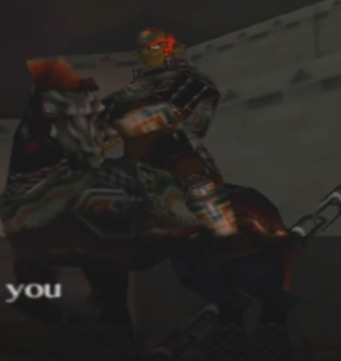
Thankfully, we have access to his model, in which we can see it a little clearer.

BUT, THE GOOD NEWS IS the folks at Dark Horse Comics were kind enough to provide us with a bunch of Ocarina of Time's concept art, which luckily included a better glimpse of that weapon!

So what is this? In my opinion, this is a design based around the curved Kirpan dagger. A curved, single-edged blade that is worn by the Khalsa as part of their religious uniform.
For my purposes, however, I want to use the concept of it being an honorable part of uniform and apply it to the Gerudo King's ascension. It is a passing-of-the-torch, if you will. Once a Gerudo male is born, he undergoes heavy training and lots of teaching, and once he passes his trials and is fully prepared to step into his role as the King of the Gerudo, he is granted this very dagger. It is a symbol to demonstrate his strength, his steady hand, his strong mind. The dings and chips broken out of the blade itself represent the Kings of the past, and the trials they faced. The blade not necessarily expected to be used but if it is used, the blood it spills is not to be washed off, but instead it is supposed to naturally flake and wear off, to remind the wielder the weight of his actions and so the life he stole will not simply be wasted and forgotten.
Ganondorf wore this dagger with pride for many years. He didn't abandon it until he got his hands on the Triforce. This is why we don't see him wearing it after Link wakes back up. He has left it back home, hidden within his private chambers in the desert and thus demonstrating his growing distance from his people and how his actions no longer resemble his interesst in protecting the Gerudo and finding ways to help them better thrive in the desert, but instead, serve his own needs and lose himself in his own greed.
He used it to kill the Composer Brothers, Sharp and Flat. He did not wash it.
10 notes
·
View notes
Text
The temperatures were below freezing, the black sky pelting those caught beneath it with a pounding rain, the winds offering ferocious howls through the spaces and gaps between sandstone structures that were meant to serve as windows. Tornadoes of blinding sand kicked up and washed over the hard surfaces, water attacked the settlement and rapidly flooded the once-bone dry water basins; it was a furious song of the worst of the desert’s dangerous habits: Mother Nature’s thunderous war scream welcomed a new life into the world. A king born on a night when the sand was not still and the air was not dry was believed to be a bad omen.
His cries competed with the violent winds that night, but legends would say his birth silenced the desert itself.
A difficult birth, Ganondorf was born to a single mother within a war-torn desert ravaged by a mightier country; the mother, her baby and their midwife, all sheltered within the small skeleton of a destroyed outpost just outside of the Desert Colossus. The settlement was once inhabited mostly by the shaman and the priestesses that tended to the goddess of the sand and her beautiful temple, and thus was familiar to Ganondorf’s mother, Twinrova – witches Koume and Kotake – even in its abandoned, sorry state.
Within their shelter's crumbling walls, the body built for this exact moment, Twinrova, cradled its precious creation – what all of the plotting and planning and forsaking and sinning had been for all this time – the first male born in one hundred years was theirs! Little Ganondorf, whose vibrant, electric-colored eyes seemed to hold the essence of a bygone era. As sisters combined looked into their child's gaze, Twinrova was transported back through time, across the bridge of many decades. The sisters’ shared heart wrenched as they recalled the violent loss of Castor, the old king, the beloved king, the gentle and fair king, and how he had fallen as he fought to protect his people. The combined memories of Koume and Kotake replayed the horrors of that fateful day in Twinrova’s mind, when the Hylians invaded and broke beyond the fortress, leaving a trail of destruction and death in their wake as they pushed deeper into the desert.
The memories flooded her mind like a relentless tide: the haunting echoes of screams, the smell of smoke and blood, and the sorrowful cries of the fallen. Kind and loving sister witches, Koume and Kotake, had been revered shaman and healers back then, devoted to the Desert Colossus, to tending to the temple and helping serve their Gerudo sisters. They could no longer bear the pain of losing their beloved, the fallen king Castor, and witnessing the suffering of their fellow Gerudo. Driven by grief and determination, they finally unleashed incredible magic meant not for the intentions of healing but instead for destruction for the first time, conjuring a mighty sandstorm to force the invaders to retreat, offering the wounded a perfect escape and protecting the fallen in their final resting places with a fierce, elemental wrath. The witches’ actions had just given birth to the Haunted Wasteland.
O’ young Gerudo king, born into a world scarred by conflict and loss!
It was in this Haunted Wasteland, during that tempestuous rain storm that welcomed Ganondorf into the world, did the destiny of Koume and Kotake’s son begin to take shape. In his eyes, Twinrova saw a glimmer of hope, a beacon of strength that would carry the Gerudo people forward. Through their son, Castor’s death would not be in vain; the destruction they suffered would be reset, healed, rebuilt. The witches vowed to nurture and guide Ganondorf, ensuring that the future of their people would be filled with unity, resilience, the spirit to persevere…
… And perhaps something more.
May the sands beneath your feet carry the wisdom of your ancestors! And in the darkness that looms, may your strength be a beacon of light to guide your people!
#The winds that blew across Hyrule brought something other... :: [HEADCANONS]#I named the old king Castor because Minish Cap takes place before Ocarina of Time#and in the west the only thing there is Castor Wilds#A searing wind punished our lands; a frigid gale pierced our homes. :: [MOTHER]#He who wields such power would make a suitable king for this world... Don’t you think? :: [THE DEMON KING]
10 notes
·
View notes
Text
𝘿𝙊𝙎𝙎𝙄𝙀𝙍 𝘾𝙃𝙀𝘼𝙏 𝙎𝙃𝙀𝙀𝙏

LEGAL NAME : Ganondorf (Dragmire is not his canon last name and I’ve never liked it)
ALIAS : The King of Thieves, The Great King of Evil, Dark Lord, Demon King, Mandrag Ganon
NICKNAME[S] : Gan.
DATE OF BIRTH : February 1st.
ASTROLOGY SIGNS : Aquarius
GENDER : Cis male
PLACE OF BIRTH : Haunted Wasteland; a small Gerudo settlement just outside of the Desert Colossus
CURRENTLY LIVING : This is entirely verse dependent; Gerudo Fortress, Gerudo Town, random Gerudo settlements and outposts, the Desert Colossus, Hyrule Castle, Ganon’s Castle, Forsaken Fortress, in Zant’s head I guess
SPOKEN LANGUAGES : Gerudo, Ancient Hylian, “Modern Hylian” (as demonstrated in Wind Waker and Tears of the Kingdom), Twili
EDUCATION : As a child, he was taught basic Gerudo education including arithmetic, reading and writing; history and lessons including life sciences, physical sciences, and natural sciences, advanced and intense Gerudo combat training and the study of weaponry; the study of arts where he excelled at organ playing, illustration and poetry writing; as he grew older and began to step into his role as King of the Gerudo, his education broadened into complex studies including social studies which include a more advanced set of lessons regarding the Gerudo’s deeper history, the history and geography of Hyrule and what the country was before it was founded, Gerudo civics, economics, and political sciences including political philosophy and methodology, the social sciences of international relations, and the implementation of public policy and governance. he received private tutoring from his mothers to learn magic, and eventually he began studying the dark arts including black magic; he sought out personal interests and extra-curriculars which included geosciences, specifically gemology, minerology and archeology, glass-blowing, philosophy, the history of modern magic, forbidden spells and magic, further combat training.
HAIR COLOR : Cinnabar.
EYE COLOR : Golden Amber.
HEIGHT : 7′6″ (228.6cm)
WEIGHT : 300lbs (This is an estimate based on ideal weight charts i’ve Googled, it didn’t really account for his muscle mass.)
FAMILY INFORMATION
SIBLING[S] : none.
PARENT[S] : Twinrova; Koume and Kotake.
RELATIVE[S] : Dead grandparents; estranged aunts.
CHILDREN : verse dependent; usually none, sometimes a beautiful pair of twin daughters.
PET[S] : A Solid Black Gerudo Stallion; Helmaroc King
RELATIONSHIP INFORMATION
SEXUAL ORIENTATION : Pansexual
RELATIONSHIP STATUS : verse dependent; usually single.
SINCE WHEN : Since his interests in pursuing the Triforce began; probably specifically once he allowed Twinrova to brainwash Nabooru.
7 notes
·
View notes
Text
I’ve decided that these holes are intended for snakes to slither through for nesting and traversing the temple. I mean I get the Gerudo were supposed to be thieves and thieves are sneaky and are supposed to get into weird places like this... but Nabooru couldn’t squeeze through so their inclusion, in regards to just the Temple itself and not gameplay puzzles, seems like it’d be for snakes to get to where they want to go more effectively and safely.
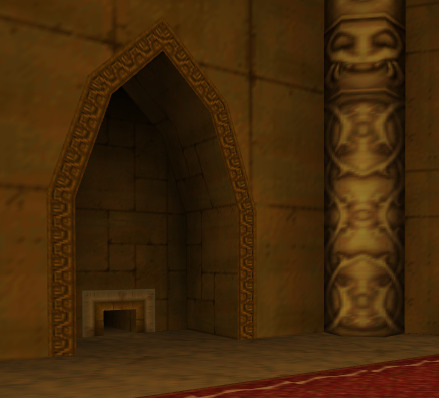
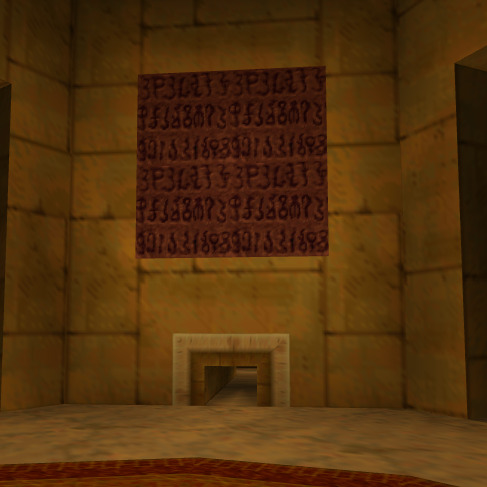
Also for the record, that plaque is just the ABCs repeated over and over again. All of the Gerudo text in this temple is. Booooring.
#Out of time. :: [OUT OF CHARACTER]#The winds that blew across Hyrule brought something other... :: [HEADCANONS]
7 notes
·
View notes
Text
"As the sun leaves us tonight, we will stand at the cusp of two worlds: a brief time when the boundary between the living and our departed grows thin. Aureate's Passage is a sacred celebration of the moment when the spirits of our cherished ancestors are said to make their journey, traversing the threshold that separates them from us. In our hearts, we thrust open the doors to welcome them in hopes they can hear our voices and we can feel their love once more."
"As we prepare our traditional meals tonight, we do so with attention and care. Tonight's gatherings and feasting will not simply be sustenance for the living, but they are offerings for those who have made their journey beyond the veil. Just as the melodies that fill the cool night air are not mere songs for entertainment, but they are echoes of our devotion to our loved ones; harmonies that serve as the mighty bridges between both realms. Remember that with each step, we do not dance alone. For tonight, we have invited our departed kin to join in our celebrations!"
"The flickering candles and the soft glow of the desert's fading sunlight will serve as beacons that guide the way for those who tread the path from the other side, safely bringing them to us during our moment of connection so that we may commune with those who have shaped our legacy... In our rituals, we find solace, in our traditions, we discover strength. Aureate's Passage is a day of remembrance, but also a day of renewal! As we draw closer to the spirits that dwell in the realms beyond, do not forget that we are connected by such deep bonds that transcend both what it means to be alive and what happens to us beyond death."

"Radiant passage, sisters. May the spirits walk beside you."
#The winds that blew across Hyrule brought something other... :: [HEADCANONS]#Happy Halloween <3#I'm so fucking late lmao
4 notes
·
View notes
Note
Do you remember the first time you took a life?

With the question presented to him, Ganondorf's usually sharp and focused gaze suddenly seems to lose its edge. The intensity that seems so deeply burned into his amber eyes now flickers and fades, giving way to something much more somber; it's as if a shadow has fallen over his powerful gleam, casting a shroud of darkness that seems to sink into the depths of what remains of his soul. The lines around his eyes deepen significantly, etching a story of pure remorse and, for a moment, the weight of his past choices bears heavily down upon him.
"Yes," he answers tersely, his voice low and dripping with the sound of regret. He takes a moment to steel himself before continuing.
"It was a moment of youthful recklessness. A dust cloud had been kicked up in the training ground and it had only amplified thanks to our frenzied sparring. My focus kept wavering and I found my attention falling back to my feet. The sands had begun to obscure the surface of the stone arena flooring, making it slick with a thin layer of shifting grains that offered little purchase for my bare soles."
"Every step I took became a careful negotiation with the ground beneath my feet and my young mind quickly lost patience. I had grown fervent and angry. With sand stinging my eyes, and my feet unable to stay steady, I tried to force myself to listen to the clashing of our metal but what I heard instead was a thud."
"I will never forget the look of disbelief in her eyes and how small she seemed crumpled to the ground in front of me... The shame that clung heavily to my shoulders and dug its nails into my flesh brought about an important lesson for a young king, but perhaps one learned in the harshest way possible."
#kneel. :: [inquiries]#You cover your face but I know who you are. :: [ANONYMOUS]#The winds that blew across Hyrule brought something other... :: [HEADCANONS]#he doesn't tell this story at all#but i figure if it's being asked this is my only chance lmao
6 notes
·
View notes
Text
Phantom Ganon circa Ocarina of Time... Y’know, this guy...
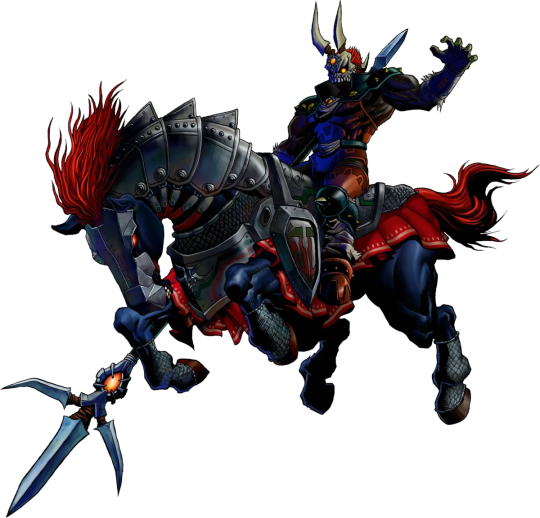
Phantom Ganon actually rides the spirit of Ganondorf’s trusty steed, the solid black Gerudo stallion. That’s why Ganondorf was in the market for a new horse--why Ingo was going to present Epona to the Great Ganondorf. Because even in the afterlife, this beautiful beast was loyal to his friend and owner.
#The winds that blew across Hyrule brought something other... :: [HEADCANONS]#I used to call Ganondorf's horse Bogus and I still continue to call him Bogus#I'm sorry but Ganondorf's beast of a horse is Bogus#I want to go further about this horse's loyalty and how that alone spawned the ghost that created phantom ganon#but i'm lazy
23 notes
·
View notes
Note
I’m sorry to hear you’re not doing well- and I hope that things improve soon!
What do you believe Ganondorf’s stance is on family? And is there anyone that he trusts?
Or if you’ve answered those previously- what is one headcanon that you’re extremely proud of, and attached to for your portrayal specifically?
"The Gerudo operate with a rather unique sense of unity and sisterhood that can be likened to a large, loving family. It was during my first diplomatic excursion to Hyrule Castle that I had learned that my race was one the few cultures whose concepts of family extend beyond simply blood relation. You see, Gerudo sisters embrace a profound bond that is born from the common thread of our heritage; many of our traditions maintain emphasis on cooperation and we rely on one another's strengths to survive within the harsh desert environment."
"From a young age, Gerudo women are shown the importance of loyalty, reliability, respect, love, and care for her fellow Gerudo. It is a cultural essence...A collective understanding that every Gerudo is connected as sisters, as mothers, as daughters, all working together to ensure the safety and well-being of one another -- especially our young ones."
"Trust is built through this strong sense of unity, which allows Gerudo mothers to know that their children are being watched over and protected even when they are not within direct sight. We commit to supporting each other; we foster an environment where we all take the roles of caregivers, protectors, and nurturers. The bustling markets, for instance, become a place of shared responsibility with everyone playing a part in looking after each other's children as though they were their own."
"My trust is placed in my mothers, for obvious reason, yes. However, many women guided me throughout my youth and they helped me navigate not only the twisting and winding road of growing up, but also my ascension. Two women were my mentors, one of which taught my basic lessons, the same foundational education that all Gerudo children receive. The second tutor meticulously prepared the noble lesson plans that were designed to prepare me for the responsibilities and challenges that came with my eventual role in leading our people. I have a small advisory council that has seemed to evolve alongside me as I grew into both my roles as prince and king. I trust my council. I trust my capable captain, Aveil... But perhaps, above all, I trust my second-in-command, Nabooru, the most."
"I trust her with knowing what decisions to make when I am unavailable, I trust that she knows what our people need. I trust her with protecting our home, our fortress, our desert, our sisters... And I trust her with handling my heart."
#kneel. :: [inquiries]#The winds that blew across Hyrule brought something other... :: [HEADCANONS]#nerieae
5 notes
·
View notes
Text
The Legend of Sariyah!
Within the heart of the formidable Gerudo fortress, a sanctuary that is nestled deep in the unforgiving desert, the sun beats down relentlessly, casting its fiery gaze on the scene, painting it with brilliant hues of molten gold and casting a striking fiery orange aura. Bathed in the unrelenting desert heat, the hidden courtyard has transformed into an enchanting arena where the boundless vitality of youthful wonderment and limitless imagination thrives and takes flight. Underfoot, the cobblestone ground, scorched by the ceaseless ardor of the sun, surrenders a gentle warmth that continues to emanate through the soles of the children's tiny, sandal-clad feet.
Here, in this mesmerizing setting, a group of excited children encircle him, the imposing and legendary Ganondorf, King of Thieves.
Curious and sparkling eyes like precious stones of topaz, amber, and citrine fixate on the king who has returned from his prolonged absence, another trip to Hyrule. His homecoming has not escaped the notice of the fortress's youngest inhabitants, who all gather closer, their little spirits filled with intrigue and excitement practically drawn to his presence like magnets.
Young Gerudo girls, their spirits untamed and brimming with life, assemble to hear the words of the monarch they've missed. His return home was met with pure childlike jubilation, but now, it is his storytelling they seek—a thrilling gift from the king who has returned from venturing where they cannot go: far beyond the desert's embrace!
As the children gather, they form a semi-circle around Ganondorf. Some of the girls, in their boundless, youthful audacity, choose instead to climb upon their king's broad shoulders, practically perched like fledgling birds upon the mighty bough of a large, strong tree. Their little hands, soft and not yet marked by the years of toiling in the desert, tug gently at the hem of his black, regal robes—the clothing he had changed into upon his return home, unwilling to remain in his heavy and uncomfortable armor for a single moment longer.
With a voice as sonorous as the desert's many secrets, the girls' proud king opts to reconnect with them by telling them a folktale that he knows by heart, one echoing with the proud spirit of Gerudo legend. His narrative, rich and resplendent like the golden sands that seem to stretch beyond the horizon and into infinity, cascades upon the children's eager ears.
Some girls lean closer, many of their faces illuminated by the mesmerizing glow of fascination as their king weaves his tale. His hands moving with the grace of a desert hawk soaring on the thermals, deftly tracing the journey of a valiant Gerudo woman named Sariyah. Effortlessly, he describes the boundless expanse of their unforgiving desert, its beauty a paradoxical testament to nature's cruel and capricious sense of humor. Utilizing words as vividly as an artist's brush on a vast canvas, the King of Thieves effortlessly conjures the images of Sariyah and her adventures within the heads of his imaginative audience, capturing their attention and inspiring the child-like creativity that resides within each one of them.
All of the Gerudo children, their eyes alight with the fires of imagination, embark on a shared odyssey, venturing themselves into the story alongside their king, accompanying Sariyah in her adventure. They envision the indomitable spirit of Sariyah, her honorable resolve and fiery determination etched against the unforgiving backdrop of the desert. The girls all immersed in the tale, marveling at the fierce and magical beauty of their arid land—a crucible that forged in the hearts of their people.
Amidst the reverie, some of the children who had taken to climbing up on Ganondorf's regal form struggle to contain their delight. Laughter spills forth like pure, crystalline waters that gush from a hidden spring. Their tiny hands, innocent, yet tenacious, clutch at his garments as they find footholds on his mighty shoulders, clinging to him both affectionately and gleefully.
The imposing king, though inwardly bemused by their antics, bears the children's playful affections with the grace of a sovereign who knows the warmth of his people's love. And so, beneath the scorching desert sun and within the storied shadow of the fortress walls, Ganondorf continues to narrate, weaving the dreams of his people's youngest generation with threads of legend, binding their hearts to their history by telling them the dusty old stories of their past.
The story of the legend of Sariyah and the desert rose comes to life before the rapt young Gerudo while the older male transforms into something more than Ganondorf, the King of Thieves. He had been their king, their mentor, a trusted guardian of their heritage, their friend, however, now he has become more than these things, for he is Ganondorf, the Storyteller.
Long ago, in a time when the desert was even harsher than it is today, there lived a young Gerudo woman named Sariyah. She possessed a spirit as fiery as the desert sun, and her determination was unmatched. Sariyah's dream was to find a way to bring life and beauty to their arid homeland, a place where the only bloom was the tenacious cactus flower.
One fateful night, as Sariyah gazed upon the endless sea of dunes within the black of the night, the shimmering dots that blanketed the sky all began to dance and bounce! Each of them coming down from their fixed places in the sky to swirl around one another and eventually join together to form a mystical creature before her. Part scorpion, part serpent, its scales shimmered in the brilliant moonlight, like the desert sands that dance at dawn, and she noticed how its eyes gleamed with an ancient wisdom.
This mystical creature spoke to Sariyah in a voice as soft as a desert breeze, "Seek the heart of the desert where the heat is most unforgiving! There, beneath the ancient palm tree, you will find a single rose unlike any other! This desert rose holds the power to bring life to the parched earth!"
With newfound determination, Sariyah embarked on her perilous journey into the heart of the desert. She faces scorching heat, violent sandstorms, and treacherous dunes. Yet, guided by the vision of that odd creature and fueled by her unwavering Gerudo spirit, Sariyah pressed on and muscled through every challenge that she encountered along the way.
Finally, after days of relentless travel, Sariyah arrived at the place the vision had foretold. There, beneath the shade of a single palm tree that stood proudly alone in the sand, she discovered a single, radiant rose. Its delicate petals seemed to glow with a warm otherworldly hue of gold, and its sweet fragrance was unlike anything she had ever smelled before!
Sariyah carefully plucked the desert rose, fearful that she had just destroyed such a precious flower. However, once the stem broke, the barren ground beneath her began to tremble and quake and for a brief moment she was certain she was being punished before life began to sprout forth from the once-dry earth! A miracle unfolded before her very eyes!
Lush greenery and vibrant flowers sprung out of the hard dirt and crystal-clear water erupted from the ground, spewing like lava from a volcano. She had to rub her eyes once she witnessed the elegant, pink glimmer that shone from a group of delicate healing fairies, the gentle creatures enjoying themselves by playfully skiing across the clear water's surface. She had effectively transformed a small portion of the desert into a healthy oasis of breathtaking beauty!
Word of Sariyah's incredible feat spread far and wide, and she became a revered figured among us Gerudo... The legend of Sariyah and that special rose lives on as a testament to the indomitable spirit of us Gerudo and the enduring magic of our desert; our home is a place where hope, like that single rose in that ocean filled with sand, can blossom in the most unexpected of ways...
#out of time. :: [out of character]#Shadow has been moved by light it seems... :: [MUSINGS]#The winds that blew across Hyrule brought something other... :: [HEADCANONS]#gonna tag this as headcanons just so i don't lose it like i know i will#i'm not very happy with this edit like at all#i might rewrite this#but i don't have the time or energy so here you go ♥#have a cute story at least!
3 notes
·
View notes
Note
What are Ganondorf's favorite hobbies/pastimes?
I love questions like this, I love the opportunity to tell you guys how human this moron is rather than have him tantrum on the dash all day long. Thank you!!!
Ganondorf has many hobbies! Starting most famously, it was in his youth that he learned to play the pipe organ. It was something productive that the witches exposed him to once he started becoming resistant with them. It was a well-kept secret that his preparations to ascend the throne did not simply only include the traditional lessons that is required of a Gerudo prince to learn. There were... extra-curriculars involved, as well. Ganondorf's youth was not his own, he was a showpony that was put through very rigorous training, so to speak.
To further his artistic endeavors, he found solace in poetry writing and even took up charcoal sketching for a time. However, these hobbies have fallen to the wayside as his interests in obtaining the Triforce took center stage. Shamefully, too, as he definitely had artistic prowess... But, seems that once Hyrule flooded and Ganondorf's kingdom of sand had crumbled, he started writing again.
Sparring is another favorite past time of his. Whether it's bare knuckle or with weapons, it doesn't matter. And if you were to ask him why, he'll probably give you a different answer every time. He loves getting his heartrate up, he loves the thrill of battle, he loves the sense of power it gives him to take a blow and answer with one of his own. Self-defense is important to him as a leader and also as someone with his lofty ambitions.
Another physical activity he enjoys is hunting. It's more of the same, being able to get exercise, being able to dominate something and kill it. He'll never admit it, but he finds more enjoyment in the thrill in taking a creature's life than he does actually eating it or using it to provide for his people.
Ganondorf is a studious sort, if he's not training somewhere, he is definitely caught up in a book. He loves to learn, he loves to absorb information, especially when it comes to magic or history. This is especially relevant to his obsessive personality, but it isn't just limited to the information his desert has collected. If he's not hiding from Hylian dignitaries, you'll definitely find him in the Great Library.
Finally, his last favorite thing to do is ride his horse. It's next to organ playing in his list of best ways to unwind from an argument with Nabooru or a stressful, suffocating encounter with those aforementioned Hylians. He often takes that solid black Gerudo stallion out for a ride just to relax... But, unfortunately, his poor horse--a breed that is built for work and bred with energy to burn--has become quite tired of these lazy strolls.
Ganondorf has neglected many things in pursuit of his precious Triforce. His people, his lover, his steed and his own person are but only a few victims.
#out of time. :: [out of character]#The winds that blew across Hyrule brought something other... :: [HEADCANONS]
4 notes
·
View notes